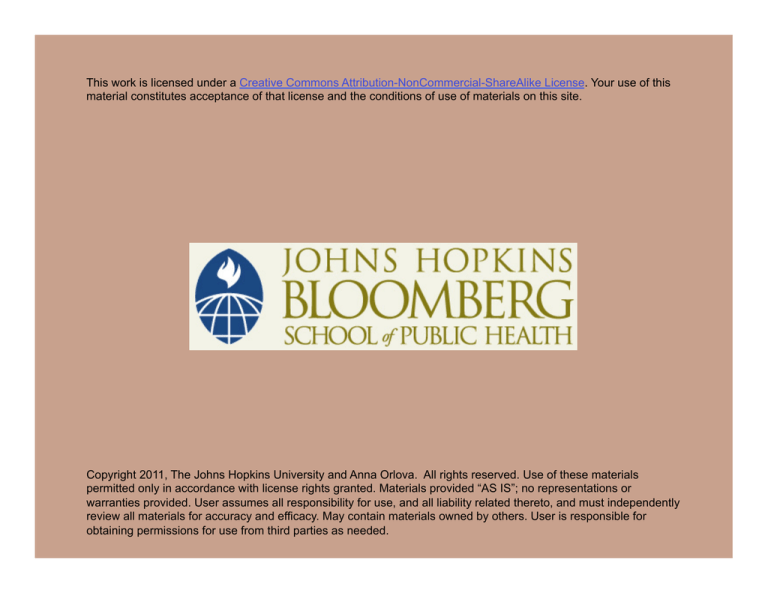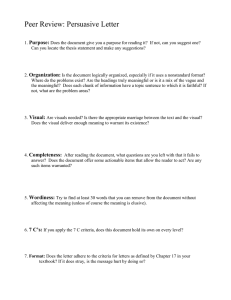
This work is licensed under a Creative Commons Attribution-NonCommercial-ShareAlike License. Your use of this
material constitutes acceptance of that license and the conditions of use of materials on this site.
Copyright 2011, The Johns Hopkins University and Anna Orlova. All rights reserved. Use of these materials
permitted only in accordance with license rights granted. Materials provided “AS IS”; no representations or
warranties provided. User assumes all responsibility for use, and all liability related thereto, and must independently
review all materials for accuracy and efficacy. May contain materials owned by others. User is responsible for
obtaining permissions for use from third parties as needed.
Towards a Nationwide Health Information
Network: Where Should We Be in 2014?
Anna O. Orlova, PhD
Johns Hopkins Bloomberg School of Public Health
Lecture Outline
National initiatives
Public health and HIT adoption
From public health reporting to bi-directional data exchanges
3
Section A
National Initiatives
The President’s Executive Order (EO) 13335
Signed May 27, 2004
The premises: to develop and nationally implement an interoperable
health IT (HIT) infrastructure that:
- Ensures that appropriate information to guide medical decisions
is available at the time and place of care
- Improves health care quality, reduces medical errors, and
advances the delivery of appropriate, evidence-based medical
care
- Reduces health care costs resulting from inefficiency, medical
errors, inappropriate care, and incomplete information
5
The President’s Executive Order (EO) 13335
-
-
-
Promotes a more effective marketplace, greater competition,
and increased choice through the wider availability of accurate
information on health care costs, quality, and outcomes
Improves the coordination of care and information among
hospitals, laboratories, physician offices, and other ambulatory
care providers through an effective infrastructure for the
secure and authorized exchange of health care information
Ensures that patients’ individually identifiable health
information is secure and protected
6
The President’s Executive Order (EO) 13335
The EO established the Office of the National Coordinator for Health
Information Technology (ONC) within HHS
- http://healthit.hhs.gov/portal/server.pt/community/
healthit_hhs_gov__home/1204
7
Towards a Nationwide Health Information Network
On July 21, 2004, ONC announced the decade of health information
technology for “delivering consumer–centric and information-rich
health care”
The vision is to build a National Health Information Network (NHIN)
of regional health information exchanges formed by health care
providers who will utilize electronic health record systems
- The original term National was changed to Nationwide in
January, 2006
Source: Thompson TG and Brailer DJ. (July 21, 2004.) The Decade of Heath Information Technology to Deliver
Consumer-centric and Information-rich Health Care. Framework for Strategic Action. US DHHS.
8
NHIN
Provider record
Laboratory results
Specialist record
Records
returned
Requests
for records
Authorized
RHIO inquiry
Another
RHIO
Patient
data to
other RHIO
Index of
where
Temporary aggregate
patients
patient history
have records
RHIO
Source: Jennie Harvell. (September, 2004). The Decade of Health Information Technology—Framework for Strategic
Actions. MMIS Conference. Office of the National Coordinator. Public Domain.
9
Vision for 2014
Used with permission of Peter Elkin. All Rights Reserved.
10
RHIOs as NHIN Components
RHIOs enable exchanges
Seamless transfer of medical information
Individual authorization of information transfer is an essential
requirement
11
Value of NHIN
Emerging data shows the value that standardized health information
exchange will provide to all stakeholders:
- Health care purchasers and payers
- Hospitals and other health care providers
- Laboratories
- Practicing clinicians
- Public health
Source: John Glaser, Janet Marchibroda, Jim Schuping. CCBH. Washington, D.C. December 6-7, 2004:
www.ehealthinitiative.com
12
Why Are We Building a NHIN?
Consumer-centric health care
- Empowerment of
consumer involvement in
health care
Strengthening health
information privacy, security
- Consumer controls on
privacy and security
- Higher risks and
opportunities for control
in an ever increasing
electronic health
information environment
Enhancing public health and
population health
- Improving public health’s
roles of surveillance,
prevention
- Improving interface of
clinical care and public
health
Expanding/improving health
literacy and education
- Accelerating health
knowledge diffusion
- Improving translation of
knowledge into practice
Source: W. Suarez. Health Information Technology and Health Information Exchanges.
Johns Hopkins Summer Institute in Health Policy and Management, June 2008.
13
NHIN Focus
Adoption of interoperable health information technology and
infrastructure to support the electronic exchange of clinical
information
New terms and entities
- Interoperability
- Standards harmonization and testing
- Product certification
- HIEs, HIT, EHRs, PHRs, RHIOs, NHIN
14
Core Definitions
Source: W. Suarez. Health Information Technology and Health Information Exchanges.
Johns Hopkins Summer Institute in Health Policy and Management, June 2008.
15
What Is Interoperability?
“The ability of different information technology systems and
software applications to:
- Communicate
- Exchange data accurately, effectively and consistently
- Use the information that has been exchanged”
Source: National Alliance for Health Information Technology. (July, 2005).
“Consensus Conventions for the Use of Key HIT Terms” Project—ONC/HHS, 2008.
16
Records Terms
Source: National Alliance for Health Information Technology. (April 28, 2008). Report to the Office of the
National Coordinator for Health Information Technology – Defining Key Health Information Technology Terms.
17
Network Terms
Source: National Alliance for Health Information Technology. (April 28, 2008). Report to the Office of the
National Coordinator for Health Information Technology – Defining Key Health Information Technology Terms.
18
RHIO and HIE
19
ARRA, 2009
The American Recovery and Reinvestment Act of 2009 authorizes
the Centers for Medicare & Medicaid Services (CMS) to provide
reimbursement incentives for eligible professionals and hospitals
who are successful in becoming “meaningful users” of certified
electronic health record (EHR) technology
These incentive payments begin in 2011 and gradually decrease
Starting in 2015, providers are expected to have adopted and be
actively utilizing a certified EHR in compliance with the “meaningful
use” definition or they will be subject to financial penalties under
Medicare
Source: Meaningful Use.
http://healthit.hhs.gov/portal/server.pt?open=512&objID=1325&parentname=CommunityPage&parentid=1&mode=2
20
Building an NHIN: National Initiatives
Meaningful use of health IT
- http://healthit.hhs.gov/portal/server.pt?
open=512&objID=1325&parentname=CommunityPage&parentid=
1&mode=2
HITECH programs
- http://healthit.hhs.gov/portal/server.pt?
open=512&objID=1487&parentname=CommunityPage&parentid=
28&mode=2&in_hi_userid=11113&cached=true
Privacy and security and health IT
-
http://healthit.hhs.gov/portal/server.pt?
open=512&objID=1147&parentname=CommunityPage&parentid=
32&mode=2&in_hi_userid=11113&cached=true
21
Building an NHIN: National Initiatives
Standards and certification
- http://healthit.hhs.gov/portal/server.pt?
open=512&objID=1153&parentname=CommunityPage&parentid=
67&mode=2&in_hi_userid=11113&cached=true
Certification and testing
- http://healthit.hhs.gov/portal/server.pt?
open=512&objID=1745&parentname=CommunityPage&parentid=
11&mode=2&in_hi_userid=10741&cached=true
22
Implementing Meaningful Use of Health IT
Staged approach
2015–2016
Future CMS rule
2013–2016
Future CMS rule
2011–2012
Current CMS NPRM
Source: W. Suarez, et.al. “Review of CMS Meaningful Use NPRM and ONC Standards and Certification IFR:
Implications for Public Health.” Presentation at JPHIT-PHDSC Webinar, February 4, 2010. Public Domain.
23
Implementing Meaningful Use of Health IT
The following pubic health programs are included in the Meaningful
Use of Health IT—Stage 1 (2011):
- Laboratory data reporting to public health agencies
- Immunization data reporting to public health agencies
- Syndromic surveillance data reporting to public health agencies
IF
Public health agencies can electronically receive them …
Source: W. Suarez, et.al. “Review of CMS Meaningful Use NPRM and ONC Standards and Certification IFR:
Implications for Public Health.” Presentation at JPHIT-PHDSC Webinar, February 4, 2010.
24
HITECH Programs
The Health Information Technology for Economic and Clinical Health
(HITECH) Act programs are designed to:
- Provide the assistance and technical support to providers
- Enable coordination and alignment within and among states
- Establish connectivity to the public health community in case of
emergencies
- Assure the workforce is properly trained and equipped to be
meaningful users of EHRs
25
HITECH Programs
State Health Information
Exchange Cooperative
Agreement Program
Curriculum Development
Centers Program
Program of Assistance for
University-Based Training
Competency Examination for
Individuals Completing NonDegree Training Program
Beacon Community Program
Health Information Technology
Extension Program
Strategic Health IT Advanced
Research Projects (SHARP)
Program
Community College Consortia
to Educate Health Information
Technology Professionals
Program
26
Privacy and Security and Health IT
Coordinated attention at the federal and state levels is needed both
to develop and implement appropriate privacy and security policies
Only by engaging all stakeholders, particularly consumers, can
health information be protected and electronically exchanged in a
manner that respects variations in individuals’ views on privacy and
access
http://healthit.hhs.gov/portal/server.pt?
open=512&objID=1147&parentname=CommunityPage&parentid=32&
mode=2&in_hi_userid=11113&cached=true
27
Standards and Certification of Health IT Products
Initial Set of Standards and Certification Criteria Interim Final Rule
(IFR): an initial set of standards, implementation specifications, and
certification criteria for complete EHRs and EHR modules for
adoption by the HHS secretary
Certification Programs Notice of Proposed Rule Making (NPRM): a
defined process to ensure that EHR technologies meet the adopted
standards, certification criteria, and other technical requirements
to achieve meaningful use of those records in systems
28
Certification and Testing
Certification of Health IT will provide assurance to purchasers and
other users that an EHR system, or other relevant technology, offers
the necessary technological capability, functionality, and security to
help them meet the meaningful use criteria established for a given
phase
http://healthit.hhs.gov/portal/server.pt?
open=512&objID=1745&parentname=CommunityPage&parentid=11&
mode=2&in_hi_userid=10741&cached=true
29
How Does all this Work?
http://healthit.hhs.gov/portal/server.pt/gateway/PTARGS_0_11673_911192_0_0_18/CertificationNPRM_webinar032510.pdf.
30
Public Domain.

